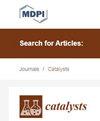Mechanism of Selective Qβ Bacteriophage Inactivation under the Presence of E. Coli Using Ground Rh-Doped SrTiO3 Photocatalyst
IF 3.8
3区 化学
Q2 CHEMISTRY, PHYSICAL
引用次数: 0
Abstract
Photocatalysts have recently attracted attention for removing infectious-disease-causing bacteria and viruses. Among such photocatalysts, ground Rh-doped SrTiO3 (“g-STO:Rh”) has been found to have biospecificity that reduces the Qβ phage infectivity under conditions that did not decrease the E. coli survival rate. Elucidating the mechanism of selective antiphage activation is important for developing photocatalysts that act effectively against specific microorganisms. In this study, SDS-PAGE and quantitative PCR showed that a g-STO:Rh-treated Qβ phage preferentially inactivated the A2 protein involved in attachment to host cells. The analysis of the photocatalyst-treated ovalbumin using g-STO:Rh indicated that the protein’s isoelectric point significantly influenced the initial interaction with g-STO:Rh. However, once the protein is absorbed, it was decomposed without the release of intermediates. Furthermore, an inactivation assay for four different phages by photocatalyst treatment using g-STO:Rh revealed that phages with positively charged proteins are highly susceptible to inactivation, and the accessibility of critical components to g-STO:Rh influences susceptibility. We conclude that the selective antiphage activation of g-STO:Rh depends on the adsorption efficiency of the protein and g-STO:Rh.使用地面掺杂 Rh 的 SrTiO3 光催化剂在大肠杆菌存在的情况下选择性灭活 Qβ 噬菌体的机制
最近,光催化剂在清除致传染病细菌和病毒方面备受关注。在这些光催化剂中,掺杂了 Rh 的 SrTiO3("g-STO:Rh")被发现具有生物特异性,能在不降低大肠杆菌存活率的条件下降低 Qβ 噬菌体的感染率。阐明选择性抗噬菌体激活的机制对于开发能有效对抗特定微生物的光催化剂非常重要。在这项研究中,SDS-PAGE 和定量 PCR 显示,经 g-STO:Rh 处理的 Qβ 噬菌体优先灭活了参与宿主细胞附着的 A2 蛋白。利用 g-STO:Rh 对经过光触媒处理的卵清蛋白进行的分析表明,蛋白质的等电点对与 g-STO:Rh 的初始相互作用有显著影响。然而,一旦蛋白质被吸收,它就会被分解,不会释放出中间产物。此外,通过使用 g-STO:Rh 进行光催化剂处理,对四种不同噬菌体进行的灭活试验表明,带有正电荷蛋白质的噬菌体非常容易被灭活,而关键成分对 g-STO:Rh 的可及性影响了灭活的敏感性。我们的结论是,g-STO:Rh 对噬菌体的选择性激活取决于蛋白质和 g-STO:Rh 的吸附效率。
本文章由计算机程序翻译,如有差异,请以英文原文为准。
求助全文
约1分钟内获得全文
求助全文
来源期刊

Catalysts
CHEMISTRY, PHYSICAL-
CiteScore
6.80
自引率
7.70%
发文量
1330
审稿时长
3 months
期刊介绍:
Catalysts (ISSN 2073-4344) is an international open access journal of catalysts and catalyzed reactions. Catalysts publishes reviews, regular research papers (articles) and short communications. Our aim is to encourage scientists to publish their experimental and theoretical results in as much detail as possible. Therefore, there is no restriction on the length of the papers. The full experimental details must be provided so that the results can be reproduced.
 求助内容:
求助内容: 应助结果提醒方式:
应助结果提醒方式:


